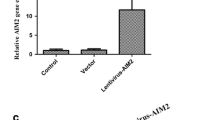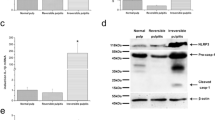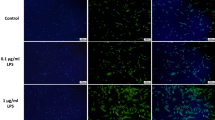Abstract
Purpose
The expression levels of intracellular pyrin domain-containing 3 (NLRP3) and microbial pattern-recognition receptors, such as nucleotide-binding oligomerization domain 2 (NOD2), have been reported in human dental pulp cells (HDPCs) and inflamed dental pulp tissue, but the role of NLRP3 and Toll-like receptors (TLRs) in the production of human beta defensin 2 (hBD2) and inflammatory cytokines against invading pathogens remains poorly defined. The aim of this study was to determine whether the NOD2 ligand muramyl dipeptide (MDP) upregulates hBD2 and inflammatory cytokines and whether this response is dependent on TLRs and NLRP inflammasomes in HDPCs.
Methodology
The effects of MDP on the expression of hBD2, TLRs, inflammasomes, and pro-inflammatory mediators in HDPCs were examined using Western blotting and reverse transcription–polymerase chain reaction. Levels of pro-inflammatory cytokines, such as nitric oxide (NO) and prostaglandin E2 (PGE2), were determined by enzyme-linked immunosorbent assay.
Results
MDP upregulated hBD2, TLR2, and TLR4 mRNAs and protein levels in a dose- and time-dependent manner. TLR2 and TLR4 neutralizing blocking antibodies and NOD2- and hBD2-specific small interfering RNAs (siRNAs) attenuated the MDP-induced production of NO, PGE2, tumor necrosis factor-α (TNF-α), interleukin-6 (IL-6), and IL-8 and upregulated inducible nitric oxide synthase (iNOS) and cyclooxygenase 2 (COX2) in HDPCs. Additionally, MDP activated inflammasome-related genes, such as NLRP3, caspase 1, apoptotic speck protein containing a caspase recruitment domain, and IL-1β. Furthermore, silencing of the NLRP3 gene using a siRNA significantly decreased the MDP-induced expression of hBD2 and cytokines, such as iNOS-derived NO, COX2, PGE2, TNF-α, IL-6, and IL-8.
Conclusion
These results suggest that NOD2 activates the TLR2, TLR4, and NLRP3 inflammasome-signaling pathways in HDPCs to induce the production of multiple inflammatory mediators and antimicrobial peptides, which in turn promote pulp immune defense against microbial challenge.
Clinical relevance
The TLR and NLRP3 inflammasome pathways may represent an important modulatory mechanism of immune defense responses during the progression of pulpitis. Our results suggest that local inhibition of NLRP3 and TLRs may reduce the impact of cytokine-mediated host destructive processes in pulpitis.






Similar content being viewed by others
References
Kumagai Y, Akira S (2010) Identification and functions of pattern-recognition receptors. J Allergy Clin Immunol 125:985–992
Kumar H, Kawai T, Akira S (2009) Pathogen recognition in the innate immune system. Biochem J 420:1–16
Inohara N, Ogura Y, Fontalba A, Gutierrez O, Pons F, Crespo J, Fukase K, Inamura S, Kusumoto S, Hashimoto M, Foster SJ, Moran AP, Fernandez-Luna JL, Nuñez G (2003) Host recognition of bacterial muramyl dipeptide mediated through NOD2. Implications for Crohn’s disease. J Biol Chem 278:5509–5512
Girardin SE, Boneca IG, Viala J, Chamaillard M, Labigne A, Thomas G, Philpott DJ, Sansonetti PJ (2003) Nod2 is a general sensor of peptidoglycan through muramyl dipeptide (MDP) detection. J Biol Chem 278:8869–8872
Lin ZM, Song Z, Qin W, Li J, Li WJ, Zhu HY, Zhang L (2009) Expression of nucleotide-binding oligomerization domain 2 in normal human dental pulp cells and dental pulp tissues. J Endod 35:838–842
Hirao K, Yumoto H, Takahashi K, Mukai K, Nakanishi T, Matsuo T (2009) Roles of TLR2, TLR4, NOD2, and NOD1 in pulp fibroblasts. J Dent Res 88:762–767
Martinon F, Agostini L, Meylan E, Tschopp J (2004) Identification of bacterial muramyl dipeptide as activator of the NALP3/cryopyrin inflammasome. Curr Biol 14:1929–1934
Yang CS, Shin DM, Jo EK (2012) The role of NLR-related protein 3 inflammasome in host defense and inflammatory diseases. Int Neurourol J 16:2–12
Song Z, Lin Z, He F, Jiang L, Qin W, Tian Y, Wang R, Huang S (2012) NLRP3 is expressed in human dental pulp cells and tissues. J Endod 38:1592–1597
Ganz T (2003) Defensins: antimicrobial peptides of innate immunity. Nat Rev Immunol 3:710–720
Dale BA, Fredericks LP (2005) Antimicrobial peptides in the oral environment: expression and function in health and disease. Curr Issues Mol Biol 7:119–133
Harder J, Meyer-Hoffert U, Teran LM, Schwichtenberg L, Bartels J, Maune S, Schröder JM (2000) Mucoid Pseudomonas aeruginosa, TNF-alpha, and IL-1beta, but not IL-6, induce human beta-defensin-2 in respiratory epithelia. Am J Respir Cell Mol Biol 22:714–721
O’Neil DA, Porter EM, Elewaut D, Anderson GM, Eckmann L, Ganz T, Kagnoff MF (1999) Expression and regulation of the human beta-defensins hBD-1 and hBD-2 in intestinal epithelium. J Immunol 163:6718–6767
Dommisch H, Winter J, Willebrand C, Eberhard J, Jepsen S (2007) Immune regulatory functions of human beta-defensin-2 in odontoblast-like cells. Int Endod J 40:300–307
Kim YS, Min KS, Lee SI, Shin SJ, Shin KS, Kim EC (2010) Effect of proinflammatory cytokines on the expression and regulation of human beta-defensin 2 in human dental pulp cells. J Endod 36:64–69
Lee SI, Min KS, Bae WJ, Lee YM, Lee SY, Lee ES, Kim EC (2011) Role of SIRT1 in heat stress- and lipopolysaccharide-induced immune and defense gene expression in human dental pulp cells. J Endod 37:1525–1530
Girardin SE, Travassos LH, Hervé M, Blanot D, Boneca IG, Philpott DJ, Sansonetti PJ, Mengin-Lecreulx D (2003) Peptidoglycan molecular requirements allowing detection by Nod1 and Nod2. J Biol Chem 278:41702–41708
Wolfert MA, Murray TF, Boons GJ, Moore JN (2002) The origin of the synergistic effect of muramyl dipeptide with endotoxin and peptidoglycan. J Biol Chem 277:39179–39186
Fritz JH, Girardin SE, Fitting C, Werts C, Mengin-Lecreulx D, Caroff M, Cavaillon JM, Philpott DJ, Adib-Conquy M (2005) Synergistic stimulation of human monocytes and dendritic cells by Toll-like receptor 4 and NOD1- and NOD2-activating agonists. Eur J Immunol 35:2459–2470
Kitagawa M, Ueda H, Iizuka S, Sakamoto K, Oka H, Kudo Y, Ogawa I, Miyauchi M, Tahara H, Takata T (2007) Immortalization and characterization of human dental pulp cells with odontoblastic differentiation. Arch Oral Biol 52:727–731
Matsuo T, Ebisu S, Nakanishi T, Yonemura K, Harada Y, Okada H (1994) Interleukin-1 alpha and interleukin-1 beta periapical exudates of infected root canals: correlations with the clinical findings of the involved teeth. J Endod 20:432–435
Pioli PA, Amiel E, Schaefer TM, Connolly JE, Wira CR, Guyre PM (2004) Differential expression of Toll-like receptors 2 and 4 in tissues of the human female reproductive tract. Infect Immun 72:5799–5806
Fahey JV, Schaefer TM, Channon JY, Wira CR (2005) Secretion of cytokines and chemokines by polarized human epithelial cells from the female reproductive tract. Hum Reprod 20:1439–1446
Horvath RJ, Nutile-McMenemy N, Alkaitis MS, Deleo JA (2008) Differential migration, LPS-induced cytokine, chemokine, and NO expression in immortalized BV-2 and HAPI cell lines and primary microglial cultures. J Neurochem 107(2):557–569
Steele C, Fidel PL Jr (2002) Cytokine and chemokine production by human oral and vaginal epithelial cells in response to Candida albicans. Infect Immun 70(2):577–583
Paris S, Wolgin M, Kielbassa AM, Pries A, Zakrzewicz A (2009) Gene expression of human beta-defensins in healthy and inflamed human dental pulps. J Endod 35:520–523
Uehara A, Fujimoto Y, Fukase K, Takada H (2007) Various human epithelial cells express functional Toll-like receptors, NOD1 and NOD2 to produce anti-microbial peptides, but not proinflammatory cytokines. Mol Immunol 44:3100–3111
Jiang HW, Zhang W, Ren BP, Zeng JF, Ling JQ (2006) Expression of Toll like receptor 4 in normal human odontoblasts and dental pulp tissue. J Endod 32:747–751
Netea MG, Ferwerda G, de Jong DJ, Jansen T, Jacobs L, Kramer M, Naber TH, Drenth JP, Girardin SE, Kullberg BJ, Adema GJ, Van der Meer JW (2005) Nucleotide-binding oligomerization domain-2 modulates specific TLR pathways for the induction of cytokine release. J Immunol 174:6518–6523
Mutoh N, Tani-Ishii N, Tsukinoki K, Chieda K, Watanabe K (2007) Expression of Toll-like receptor 2 and 4 in dental pulp. J Endod 33:1183–1186
Uehori J, Fukase K, Akazawa T, Uematsu S, Akira S, Funami K, Shingai M, Matsumoto M, Azuma I, Toyoshima K, Kusumoto S, Seya T (2005) Dendritic cell maturation induced by muramyl dipeptide (MDP) derivatives: monoacylated MDP confers TLR2/TLR4 activation. J Immunol 174:7096–7103
Vora P, Youdim A, Thomas LS, Fukata M, Tesfay SY, Lukasek K, Michelsen KS, Wada A, Hirayama T, Arditi M, Abreu MT (2004) Beta-defensin-2 expression is regulated by TLR signaling in intestinal epithelial cells. J Immunol 173(9):5398–5405
Miyauchi M, Takata T, Ito H, Ogawa I, Kobayashi J, Nikai H, Ijuhin N (1996) Immunohistochemical demonstration of prostaglandins E2, F2 alpha, and 6-keto-prostaglandin F1 alpha in rat dental pulp with experimentally induced inflammation. J Endod 22:600–602
Tani-Ishii N, Wang CY, Stashenko P (1995) Immunolocalization of bone-resorptive cytokines in rat pulp and periapical lesions following surgical pulp exposure. Oral Microbiol Immunol 10:213–219
Zehnder M, Delaleu N, Du Y, Bickel M (2003) Cytokine gene expression—part of host defence in pulpitis. Cytokine 22:84–88
Jeon DI, Park SR, Ahn MY, Ahn SG, Park JH, Yoon JH (2012) NOD1 and NOD2 stimulation triggers innate immune responses of human periodontal ligament cells. Int J Mol Med 29:699–703
Lee SI, Kim GT, Kim HJ, Park SH, Kim EC (2014) NOD2 mediates odontoblast differentiation and RANKL expression. J Dent Res 93(7):678–684
Li Q, Kumar A, Gui JF, Yu FS (2008) Staphylococcus aureus lipoproteins trigger human corneal epithelial innate response through toll-like receptor-2. Microb Pathog 44:426–434
Voss E, Wehkamp J, Wehkamp K, Stange EF, Schröder JM, Harder J (2006) NOD2/CARD15 mediates induction of the antimicrobial peptide human beta-defensin-2. J Biol Chem 281:2005–2011
Li ZZ, Tao LL, Zhang J, Zhang HJ, Qu JM (2012) Role of NOD2 in regulating the immune response to Aspergillus fumigatus. Inflamm Res 61:643–648
Strober W, Murray PJ, Kitani A, Watanabe T (2006) Signalling pathways and molecular interactions of NOD1 and NOD2. Nat Rev Immunol 6:9–20
Watanabe T, Kitani A, Murray PJ, Strober W (2004) NOD2 is a negative regulator of Toll-like receptor 2-mediated T helper type 1 responses. Nat Immunol 5:800–808
Silva AC, Faria MR, Fontes A, Campos MS, Cavalcanti BN (2009) Interleukin-1 beta and interleukin-8 in healthy and inflamed dental pulps. J Appl Oral Sci 17:527–532
Hosoya S, Matsushima K (1997) Stimulation of interleukin-1 beta production of human dental pulp cells by Porphyromonas endodontalis lipopolysaccharide. J Endod 23:39–42
Bauernfeind FG, Horvath G, Stutz A, Alnemri ES, MacDonald K, Speert D, Fernandes-Alnemri T, Wu J, Monks BG, Fitzgerald KA, Hornung V, Latz E (2009) Cutting edge: NF-kappaB activating pattern recognition and cytokine receptors license NLRP3 inflammasome activation by regulating NLRP3 expression. J Immunol 183:787–791
Witzenrath M, Pache F, Lorenz D, Koppe U, Gutbier B, Tabeling C, Reppe K, Meixenberger K, Dorhoi A, Ma J, Holmes A, Trendelenburg G, Heimesaat MM, Bereswill S, van der Linden M, Tschopp J, Mitchell TJ, Suttorp N, Opitz B (2011) The NLRP3 inflammasome is differentially activated by pneumolysin variants and contributes to host defense in pneumococcal pneumonia. J Immunol 187:434–440
Rajamäki K, Lappalainen J, Oörni K, Välimäki E, Matikainen S, Kovanen PT, Eklund KK (2010) Cholesterol crystals activate the NRRP3 inflammasome in human macrophages: a novel link between cholesterol metabolism and inflammation. PLoS One 23:e11765
Acknowledgments
This study was supported by the National Research Foundation of Korea (NRF) grant funded by the Korea government (MSIP) (no. 2012R1A5A2051384) and by a grant of the Korea Healthcare Technology R & D Project, Ministry for Health, Welfare & Family Affairs, Republic of Korea (A111412).
Conflict of interest
The authors declare no conflicts of interest.
Author information
Authors and Affiliations
Corresponding authors
Additional information
Young-Dae Kwon and Eun-Cheol Kim contributed equally to this work as corresponding authors.
Rights and permissions
About this article
Cite this article
Lee, SI., Kang, SK., Jung, HJ. et al. Muramyl dipeptide activates human beta defensin 2 and pro-inflammatory mediators through Toll-like receptors and NLRP3 inflammasomes in human dental pulp cells. Clin Oral Invest 19, 1419–1428 (2015). https://doi.org/10.1007/s00784-014-1361-8
Received:
Accepted:
Published:
Issue Date:
DOI: https://doi.org/10.1007/s00784-014-1361-8




